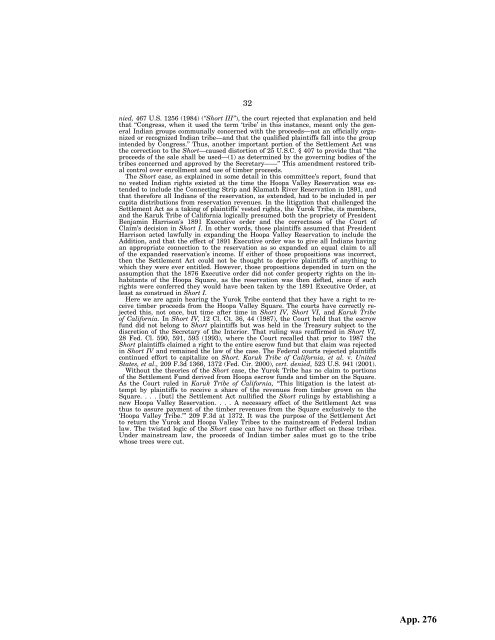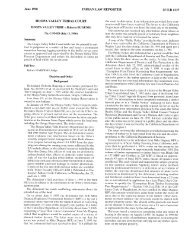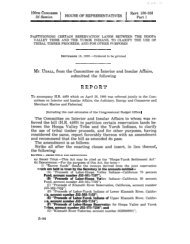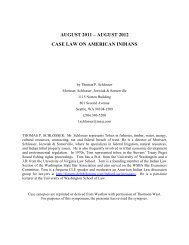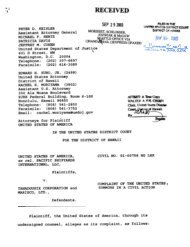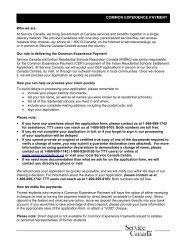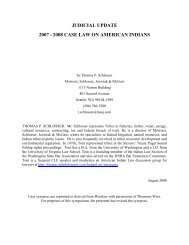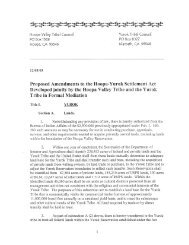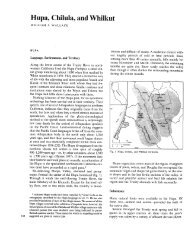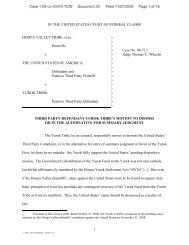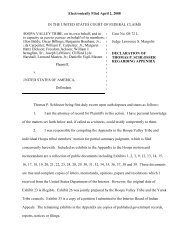Hoopa appendix supporting summary judgment - Schlosser Law Files
Hoopa appendix supporting summary judgment - Schlosser Law Files
Hoopa appendix supporting summary judgment - Schlosser Law Files
Create successful ePaper yourself
Turn your PDF publications into a flip-book with our unique Google optimized e-Paper software.
32<br />
nied, 467 U.S. 1256 (1984) (‘‘Short III’’), the court rejected that explanation and held<br />
that ‘‘Congress, when it used the term ‘tribe’ in this instance, meant only the general<br />
Indian groups communally concerned with the proceeds—not an officially organized<br />
or recognized Indian tribe—and that the qualified plaintiffs fall into the group<br />
intended by Congress.’’ Thus, another important portion of the Settlement Act was<br />
the correction to the Short—caused distortion of 25 U.S.C. § 407 to provide that ‘‘the<br />
proceeds of the sale shall be used—(1) as determined by the governing bodies of the<br />
tribes concerned and approved by the Secretary——’’ This amendment restored tribal<br />
control over enrollment and use of timber proceeds.<br />
The Short case, as explained in some detail in this committee’s report, found that<br />
no vested Indian rights existed at the time the <strong>Hoopa</strong> Valley Reservation was extended<br />
to include the Connecting Strip and Klamath River Reservation in 1891, and<br />
that therefore all Indians of the reservation, as extended, had to be included in per<br />
capita distributions from reservation revenues. In the litigation that challenged the<br />
Settlement Act as a taking of plaintiffs’ vested rights, the Yurok Tribe, its members,<br />
and the Karuk Tribe of California logically presumed both the propriety of President<br />
Benjamin Harrison’s 1891 Executive order and the correctness of the Court of<br />
Claim’s decision in Short I. In other words, those plaintiffs assumed that President<br />
Harrison acted lawfully in expanding the <strong>Hoopa</strong> Valley Reservation to include the<br />
Addition, and that the effect of 1891 Executive order was to give all Indians having<br />
an appropriate connection to the reservation as so expanded an equal claim to all<br />
of the expanded reservation’s income. If either of those propositions was incorrect,<br />
then the Settlement Act could not be thought to deprive plaintiffs of anything to<br />
which they were ever entitled. However, those propositions depended in turn on the<br />
assumption that the 1876 Executive order did not confer property rights on the inhabitants<br />
of the <strong>Hoopa</strong> Square, as the reservation was then defted, since if such<br />
rights were conferred they would have been taken by the 1891 Executive Order, at<br />
least as construed in Short I.<br />
Here we are again hearing the Yurok Tribe contend that they have a right to receive<br />
timber proceeds from the <strong>Hoopa</strong> Valley Square. The courts have correctly rejected<br />
this, not once, but time after time in Short IV, Short VI, and Karuk Tribe<br />
of California. In Short IV, 12 Cl. Ct. 36, 44 (1987), the Court held that the escrow<br />
fund did not belong to Short plaintiffs but was held in the Treasury subject to the<br />
discretion of the Secretary of the Interior. That ruling was reaffirmed in Short VI,<br />
28 Fed. Cl. 590, 591, 593 (1993), where the Court recalled that prior to 1987 the<br />
Short plaintiffs claimed a right to the entire escrow fund but that claim was rejected<br />
in Short IV and remained the law of the case. The Federal courts rejected plaintiffs<br />
continued effort to capitalize on Short. Karuk Tribe of California, et al. v. United<br />
States, et al., 209 F.3d 1366, 1372 (Fed. Cir. 2000), cert. denied, 523 U.S. 941 (2001).<br />
Without the theories of the Short case, the Yurok Tribe has no claim to portions<br />
of the Settlement Fund derived from <strong>Hoopa</strong> escrow funds and timber on the Square.<br />
As the Court ruled in Karuk Tribe of California, ‘‘This litigation is the latest attempt<br />
by plaintiffs to receive a share of the revenues from timber grown on the<br />
Square. . . . [but] the Settlement Act nullified the Short rulings by establishing a<br />
new <strong>Hoopa</strong> Valley Reservation. . . . A necessary effect of the Settlement Act was<br />
thus to assure payment of the timber revenues from the Square exclusively to the<br />
‘<strong>Hoopa</strong> Valley Tribe.’’’ 209 F.3d at 1372. It was the purpose of the Settlement Act<br />
to return the Yurok and <strong>Hoopa</strong> Valley Tribes to the mainstream of Federal Indian<br />
law. The twisted logic of the Short case can have no further effect on these tribes.<br />
Under mainstream law, the proceeds of Indian timber sales must go to the tribe<br />
whose trees were cut.


